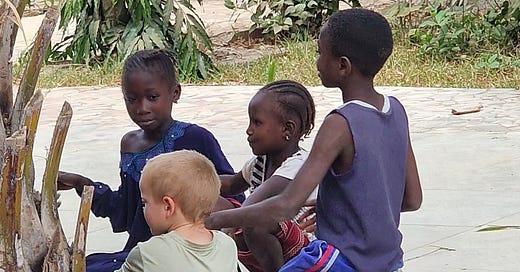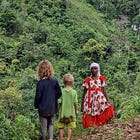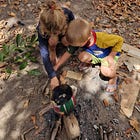It is a truth universally acknowledged that without seeming to emit any call or signal, children somehow attract other children. I have watched this phenomenon in the deepest parts of the Amazon rainforest, on small islands in the Indian Ocean, and, this one time, in inland Gambia where nobody's really sure if the local shop is in Senegal or not.
My three children had been playing with two kids from the village. Then, apparently out of nowhere, two more had appeared, and now there was a collection of ten or so, ranging in age from twelve or thirteen down to a little one-year-old, who’d been carried in by one of the older girls. I was in the shade of our hut, watching.
The older kids had brought a rusty adult bike and they were working out how to get on and ride it, but my attention was held by the toddler. I’d never seen such a young child doing his own thing without parental attention before. He kicked in the dust, grubbled in the sand, and wandered over to watch the bike experimentation from the sidelines. He picked some leaves, lay on his back, and watched the branches of the big old mango tree waving above his head. No-one told him what to do, no-one tried to direct his play. When the older children peeled some green mangoes, they offered him a piece, and he solemnly took it and chewed on it. At one point, one of the older kids, responding to something I hadn’t noticed, undressed him and held him to wee next to the tree. There were no tears, no conflicts, no tantrums. No one was trying to bend anyone else to their will.
The younger ones were fascinated by the older ones, mimicking and learning from them. The older ones were happy to lead and be respected. Somewhere, the ghost of William Golding was looking kind of sheepish, and trying to change the subject.
I’d barely seen multi-age groups of children playing together in the UK, and certainly not a group with ten years between the oldest and youngest. Typically, my kids would play only with children in their class. The older children had no interest in playing with the younger ones. What magic was compelling them to play so nicely here?
Perhaps part of it was the bicycle. A goal can bring people together, especially if that goal includes fixing something, but there was more to it. I soon realised that the relaxed attitude came from a lack of watching adults. No adults to fix the problems they could see possibly arising, or to blunder in and ‘smooth over’ awkward social situations. Without that, these children had had to become masters of compromise and communication, but most of it was non-verbal. After all, my children couldn’t speak Mandinka, and some of the smallest in the group didn't speak anything at all. I watched from my make-shift hide. Younger children were corrected with a frown, a slight headshake, or a gentle redirection of a hand, and the correct behaviour was demonstrated.
If you’d asked me before I’d left the UK if the children spent time unsupervised, I’d’ve said “Sure!” I knew, theoretically, that unsupervised time was good for helping children develop a sense of autonomy, their problem solving skills, and their self confidence. After all, I’d often be cooking in the other room, or they’d be out in the garden alone. Sometimes I even dared to let them play ‘unsupervised’ out the front of the house.
But it wasn’t really unsupervised. It wasn’t until I watched hundreds of children in more traditional villages across South America and Africa that I realised what unsupervised really means. Unsupervised time is time in which an adult is just too far away to sort out the simple age-appropriate problems that a child faces. And that varies with age. For a toddler, it might be the next room. For a five-year-old, it might be the next street. And so on.
Unsupervised time means that children
Have to work out solutions to simple problems themselves because there’s no sympathetic adult within range
Have to seek help from unfamiliar adults or change their plans if there is a problem that they can’t fix
Have to use compromise and negotiation skills with their peers
When children are unsupervised, tale-telling isn’t a behaviour that has any reward. There’s no point complaining to an adult about a child’s behaviour if there isn’t an adult who wants to listen. Instead, children have to learn to deal with the emotional discomfort and work through conflict, helping them develop a tolerance for frustration that will serve them well through life. In our risk-averse, anxious culture, people often report others to nameless authority figures (the council, the police, the school) rather than initiating conversations. How much of that adult tale-telling comes from children who never learned the skills of living without supervision?
But unsupervised time isn’t just good for children. Unsupervised time means that parents
Have to have set expectations with their children about how their children should behave
Have to trust children to act appropriately on their own
Have to get used to letting their children go.
And these are incredibly hard skills to learn. Painful even. Trust me. But we have to learn them. Failure to do so has two possible outcomes: 1, you withdraw support later when children have become over reliant on it and they resent being plunged into the icy waters of adolescence without warning, or 2, you never withdraw support and up with hyper-dependent older children with no self confidence. Neither of these two outcomes is fun, but both have the downside much later which makes them easy to reach by accident (a recurring theme in all of parenthood).
We can’t possibly always be there for our children, so the best thing we can do is to help them be there for themselves.
Learning to let children face and overcome their own challenges is a skill that takes a lot of practise. The later you leave it, the longer you’ve been practising intervening and taking over, and the harder it becomes to not do that. For this reason, I have mixed feelings about tracking devices on children. Sure, in the very unlikely situation that something bad happens to your child, a tracking device could be invaluable. But being able to constantly check in on their whereabouts may give parents an illusion of control, it removes a child’s privacy, and it makes it harder for parents to find the bravery to make the jump into fully trusting our children to make good decisions.
If we really stop and think about it, we all want our children to have healthy adult relationships and fulfilled lives with a sense of contribution and purpose. We want them to be mentally healthy and able to cope with the normal ups and downs of life. So what can we do?
Start small and young. If your three-year-old falls over at the park, or has a conflict with another child, avoid catching their eye. If the child isn’t hurt, they’ll likely decide that it’s too much effort to call you over and explain the problem. If they are hurt, then they’ll let you know. Looking the other way is a very effective way of starting to increase a child’s ability to self-manage mildly difficult situations.
Don’t reward tale-telling within the family. If a child comes over to tell you about another child, say “that sounds like you’re telling a tale. You should be talking to them, not me. I’m sure you can sort it out.” Children rapidly learn which adults welcome tale-tellers, and those who do not. (NB - make it clear that there are specific situations in which tale-telling is appropriate - situations that put anyone at risk of serious injury, as a starter).
Don’t try to fix a child’s problem. Listen, empathise, and ask how the child plans to sort it out. The book “How to talk so kids will listen and listen so kids will talk” has some great graphics to illustrate this.
Practise giving children unsupervised time from a young age, and gradually build up. For toddlers, it might be telling them that you are going to sit down with a book for half an hour and you will not play with them.
Let children go to school by themselves. A child who learns how to go to school unsupervised also learns how to get their bag ready, keep an eye on the time, and lock up the house. There are many skills that come along with unsupervised responsibilities. And most countries know it. The UK and US are very much exceptions. Children walk to school unsupervised in most European countries.
Let children run errands at the local shop, play at the park, or check books out of the library. My sister lives in the Netherlands and she’s seen six-year-olds turn up on their bikes to play at the park. No-one blinks an eye. These skills require some practise and some preparation, but they tick multiple boxes - unsupervised time, responsible time, time outside, and time moving.
In the UK, we have an epidemic of poor mental health in our children and adolescents. By many metrics young Brits are the most miserable, most scared youths in our continent. Unsupervised time for young children is the antidote. It’s the time when they build their belief in their ability to cope and solve problems alone, while they still have no self-consciousness around looking incompetent. That’s why they are so motivated to do things for themselves. But if we miss that critical window, we end up with dissatisfied, demoralised, disempowered teenagers, who feel that they can’t do anything, don’t want to talk about it, and can’t think of a solution for themselves.
Let’s capitalise on that critical period. Let’s empower our primary-school kids to feel like they can do things, they can fix things, and they can solve their problems. By themselves.
You may also like:
Notes
A 2006 study found that unsupervised adolescent girls were more physically active than those who were supervised: https://link.springer.com/article/10.1186/1479-5868-3-20
A recent review discusses the unintentional impact of supervisory neglect laws in the US, and talks about how the evidence on child development isn’t reflected within the legislative framework. It also discussed how certain states are protecting child independence “In 2018, Utah (2018) redefined its neglect law to define childhood independence stating, “Neglect does not include permitting a child who is of sufficient age and maturity to avoid harm or unreasonable risk of harm, to engage in independent activities, including: (A) traveling to and from school, including by walking, running, or bicycling; (B) traveling to and from nearby commercial or recreational facilities; (C) engaging in outdoor play; (D) remaining in a vehicle unattended; (E) remaining at home unattended; or (F) engaging in a similar independent activity.” https://srcd.onlinelibrary.wiley.com/doi/full/10.1002/sop2.27








I’m thankful to live in a place (rural America) where my kids can roam, unsupervised. My bigger ones (14, 17) ride their 4 wheelers and go carts through town to the ditch banks to ride. My middle two (8, 9) often walk half mile across town to the library and park, or go browse the aisles at the hardware store. They’ve even bought things, tires for their bikes, pushing their bikes to the hardware store so they can make sure to get the right size and then asking the store owner for help. I’ve made my expectations clear as to behavior, where they plan on going, looking out for one another, wearing helmets, etc. There’s been a time with each where they’ve lost the privilege of being unsupervised, but they value the freedom so they learn quickly not to push the boundaries. It truly is a blessing to live in a place like this.